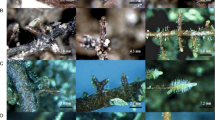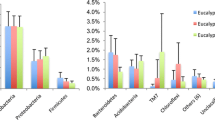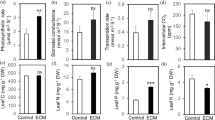Abstract
Recently, ergosterol analysis has been used to quantify viable fungal biomass in resynthesized ectomycorrhizae. An objective of our study was to quantify ergosterol in a range of ectomycorrhizal isolates under differing growth conditions. In addition, we tested the applicability of the method on field-collected roots of ectomycorrhizal and vesicular-arbuscular (VA) mycorrhizal plants. Quantification of sitosterol as a biomass indicator of plant roots was also undertaken. Ergosterol was not detected in roots of uninoculated Betula populifolia seedlings, and sitosterol was not detected in an ectomycorrhizal fungal isolate but was present in birch roots. Ergosterol was produced in all isolates examined, which represented the major orders of ectomycorrhizal fungi. The range of values obtained, from 3 to nearly 18 μg ergosterol mg-1 dry mass, agrees well with reported values for other mycorrhizal and decomposer fungi. Hyphal ergosterol was the same during growth on phytic acid and KH2PO4. Reduction of growth temperature from 25° C to 15° C had little effect on ergosterol content of cultures harvested at similar growth stages. Ergosterol and sitosterol were detected in field-collected ectomycorrhizae of B. populifolia and Pinus sylvestris and VA mycorrhizae of Acer rubrum and Plantago major. Both ergosterol content and ergosterol to sitosterol ratios were significantly lower in VA mycorrhizae than ectomycorrhizae. Calculations of viable fungal biomass associated with field-collected roots were in agreement with those reported by others using the method on resynthesized ectomycorrhizae. Estimates of total mass could be obtained for field-collected B. populifolia roots by a simultaneously using ergosterol to estimate fungal biomass and sitosterol to estimate root mass. Some potential applications and limitations of sterol quantification in studies of mycorrhizal physiology and ecology are discussed.
Similar content being viewed by others
References
Arnezeder C, Hampel WA (1991) Influence of growth rate on the accumulation of ergosterol in yeast cells. Biotechnol Lett 12:277–282
Bergmann W (1953) The plant sterols. Annu Rev Plant Physiol 4:383–426
Brundrett MC (1991) Mycorrhizas in natural ecosystems. Adv Ecol Res 21:171–313
Brundrett MC, Piche Y, Peterson RL (1984) A new method for observing the morphology of vesicular-arbuscular mycorrhizae. Can J Bot 62:2128–2134
Dexter Y, Cooke RC (1984) Fatty acids, sterols and carotenoids of the psychrophile Mucor strictus and some mesophilic Mucor species. Trans Br Mycol Soc 83:455–461
Fogel R (1980) Mycorrhizae and nutrient cycling in natural forest ecosystems. New Phytol 86:199–212
Fogel R (1985) Roots as primary producers in below-ground ecosystems. In: Fitter A (ed) Ecological interactions in soil. Cambridge University Press, Cambridge, pp 23–36
Frankland JC, Harrison AF (1985) Mycorrhizal infection of Betula pendula and Acer pseudoplatanus: relationships with seedling growth and soil factors. New Phytol 101:133–151
Frey B, Buser H-R, Schuepp H (1992) Identification of ergosterol in vesicular-arbuscular mycorrhizae. Biol Fertil Soils 13:229–234
Harley JL (1971) Fungi in ecosystems. J Appl Ecol 8:627–642
Harley JL (1989) The significance of mycorrhiza. Mycol Res 92:129–139
Harley JL, Smith SE (1983) Mycorrhizal symbiosis. Academic Press, London
Harvey AE, Larsen MJ, Jurgensen MF (1976) Distribution of ectomycorrhizae in a mature Douglas fir/larch forest soil in western Montana. For Sci 22:393–398
Hepper CM (1977) A colonization method for estimating vesicular-arbuscular mycorrhizal infection in roots. Soil Biol Biochem 9:15–18
Heupel RC (1989) Isolation and primary characterization of sterols. In: Nes WD, Parish EJ (eds) Analysis of sterols and other biologically significant steroids. Academic Press, San Diego, pp 1–31
Jabaji-Hare S (1988) Lipid and fatty acid profiles of some vesicular-arbuscular mycorrhizal fungi: contribution to taxonomy. Mycologia 80:622–629
Jakobsen I, Rosendahl L (1990) Carbon flow into soil and external hyphae from roots of mycorrhizal cucumber plants. New Phytol 115:77–83
Johnson BN, McGill WB (1990a) Comparison of ergosterol and chitin as quantitative estimates of mycorrhizal infection and Pinus contorta seedling response to inoculation. Can J For Res 20:1125–1131
Johnson BN, McGill WB (1990b) Variations in ergosterol content and ornithine decarboxylase activity of ectomycorrhizal root systems. Plant Soil 127:71–79
Linkins AE, Antibus RK (1982) Mycorrhizae of Salix rotundifolia in coastal arctic tundra. In: Laursen GA, Ammirati JF (eds) Arctic and alpine mycology. University of Washington Press, Seattle, pp 509–531
Martin F, Delaruelle C, Hubert J-L (1990) An improved ergosterol assay to estimate fungal biomass in ectomycorrhizas. Mycol Res 94:1059–1064
Maser C, Trappe JM, Nussbaum RA (1978) Fungal/small mammal interrelationships with emphasis on Oregon coniferous forests. Ecology 59:799–809
Miller OK, Watling R (1987) Whence cometh the agarics? A reappraisal. In: Rayner ADM, Brasier CM, Moore D (eds) Evolutionary biology of the fungi. Cambridge University Press, Cambridge, pp 435–448
Miller RM, Jastrow JD (1990) Hierarchy of root and mycorrhizal fungal interactions with soil aggregation. Soil Biol Biochem 22:579–584
Molina R, Palmer JG (1982) Isolation, maintenance, and pure culture manipulation of ectomycorrhizal fungi. In: Schenck NC (ed) Methods and principles of mycorrhizal research. American Phytopathological Society, St Paul, Minn, pp 115–129
Newell SY, Fallon RD (1991) Toward a method for measuring instantaneous fungal growth rates in field samples. Ecology 72:1547–1559
Newell SY, Miller JD, Fallon RD (1987) Ergosterol content of salt-marsh fungi: effect of growth conditions and mycelial age. Mycologia 79:688–695
Newell SY, Arsuffi TL, Fallon RD (1988) Fundamental procedures for determining ergosterol content of decaying plant material by liquid chromatography. Appl Environ Microbiol 54:1876–1879
Osswald WF, Holl W, Elstner EF (1986) Ergosterol as a biochemical indicator of fungal infection in spruce and fir needles from different sources. Z Naturforsch [C] 41:542–546
Paul EA, Kucey RMN (1981) Carbon flow in plant microbial associations. Science 213:473–474
Plassard C, Mousain D, Salsac L (1983) Dosage de la chitine sur des ectomycorhizes de pin maritime (Pinus pinaster) a Pisolithus tinctorius: evaluation de la masse mycelienne et de la mycorhization. Can J Bot 61:692–699
Ponge JF (1988) Etude ecologique d'un humus forestier par l'observation d'un petit volume. III. La couche f1 d'un moer sous Pinus sylvestris. Pedobiologia 31:1–64
Rousseau JVD, Reid CPP (1991) Effects of phosphorus fertilization and mycorrhizal development on phosphorus nutrition and carbon balance of loblolly pine. New Phytol 117:319–326
Salmanowicz B, Nylund J-E (1988) High performance liquid chromatography determination of ergosterol as a measure of ectomycorrhiza infection in Scots pine. Eur J Phytopathol 18:291–298
Vogt KA, Grier CC, Meier CE, Edmonds RL (1982) Mycorrhizal role in net primary production and nutrient cycling in Abies amabilis ecosystems in western Washington. Ecology 63:370–380
Weete JD (1980) Lipid biochemistry of fungi and other organisms. Plenum Press, New York
West AW, Grant WD (1987) Use of ergosterol, diaminopimelic acid and glucosamine contents of soils to monitor changes in microbial populations. Soil Biol Biochem 19:607–612
Author information
Authors and Affiliations
Rights and permissions
About this article
Cite this article
Antibus, R.K., Sinsabaugh, R.L. The extraction and quantification of ergosterol from ectomycorrhizal fungi and roots. Mycorrhiza 3, 137–144 (1993). https://doi.org/10.1007/BF00208921
Issue Date:
DOI: https://doi.org/10.1007/BF00208921




